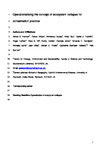Operationalising the concept of ecosystem collapse for conservation practice
| dc.contributor.author | Newton, AC | |
| dc.contributor.author | Britton, R | |
| dc.contributor.author | Davies, K | |
| dc.contributor.author | Diaz, A | |
| dc.contributor.author | Franklin, DJ | |
| dc.contributor.author | Herbert, RJH | |
| dc.contributor.author | Hill, RA | |
| dc.contributor.author | Hodder, K | |
| dc.contributor.author | Jones, G | |
| dc.contributor.author | Korstjens, AH | |
| dc.contributor.author | Lamb, A | |
| dc.contributor.author | Olley, J | |
| dc.contributor.author | Pinder, AC | |
| dc.contributor.author | Roberts, CG | |
| dc.contributor.author | Stafford, R | |
| dc.date.accessioned | 2022-02-08T12:13:17Z | |
| dc.date.available | 2022-02-08T12:13:17Z | |
| dc.date.issued | 2021-12 | |
| dc.identifier.issn | 0006-3207 | |
| dc.identifier.issn | 1873-2917 | |
| dc.identifier.other | 109366 | |
| dc.identifier.uri | http://hdl.handle.net/10026.1/18661 | |
| dc.description.abstract |
Concern is growing about ecosystem collapse, namely the abrupt decline or loss of an ecosystem resulting from human activities. While efforts to assess the risk of ecosystem collapse have developed at large spatial scales, less attention has been given to the local scales at which conservation management decisions are typically made. Development of appropriate management responses to ecosystem collapse has been limited by uncertainty regarding how collapse may best be identified, together with its underlying causes. Here we operationalise ecosystem collapse for conservation practice by providing a robust definition of collapse, in a form that is relevant to the scale of conservation decision-making. We provide an overview of different causes of collapse, and then explore the implications of this understanding for conservation practice, by examining potential management responses. This is achieved through development of a decision tree, which we illustrate through a series of case studies. We also explore the role of indicators for the early detection of collapse and for monitoring the effectiveness of management responses. Ecosystem collapse represents a significant challenge to conservation practice, as abrupt changes in ecosystem structure, function and composition can occur with little warning, leading to profound impacts on both biodiversity and human society. The risks of ecosystem collapse are likely to increase in future, as multiple forms of environmental change continue to intensify. We suggest that selection of management responses should be based on an understanding of the causal mechanisms responsible for collapse, which can be identified through appropriate monitoring and research activities. | |
| dc.format.extent | 109366-109366 | |
| dc.language | en | |
| dc.language.iso | en | |
| dc.publisher | Elsevier BV | |
| dc.subject | Ecosystem collapse | |
| dc.subject | Biodiversity loss | |
| dc.subject | Conservation | |
| dc.subject | Environmental management | |
| dc.subject | Degradation | |
| dc.subject | Regime shift | |
| dc.title | Operationalising the concept of ecosystem collapse for conservation practice | |
| dc.type | journal-article | |
| plymouth.author-url | https://www.webofscience.com/api/gateway?GWVersion=2&SrcApp=PARTNER_APP&SrcAuth=LinksAMR&KeyUT=WOS:000719372700011&DestLinkType=FullRecord&DestApp=ALL_WOS&UsrCustomerID=11bb513d99f797142bcfeffcc58ea008 | |
| plymouth.volume | 264 | |
| plymouth.publication-status | Published | |
| plymouth.journal | Biological Conservation | |
| dc.identifier.doi | 10.1016/j.biocon.2021.109366 | |
| plymouth.organisational-group | /Plymouth | |
| plymouth.organisational-group | /Plymouth/Faculty of Science and Engineering | |
| plymouth.organisational-group | /Plymouth/Users by role | |
| plymouth.organisational-group | /Plymouth/Users by role/Academics | |
| dcterms.dateAccepted | 2021-10-12 | |
| dc.rights.embargodate | 2023-9-12 | |
| dc.identifier.eissn | 1873-2917 | |
| dc.rights.embargoperiod | Not known | |
| rioxxterms.versionofrecord | 10.1016/j.biocon.2021.109366 | |
| rioxxterms.licenseref.uri | http://www.rioxx.net/licenses/all-rights-reserved | |
| rioxxterms.type | Journal Article/Review |


